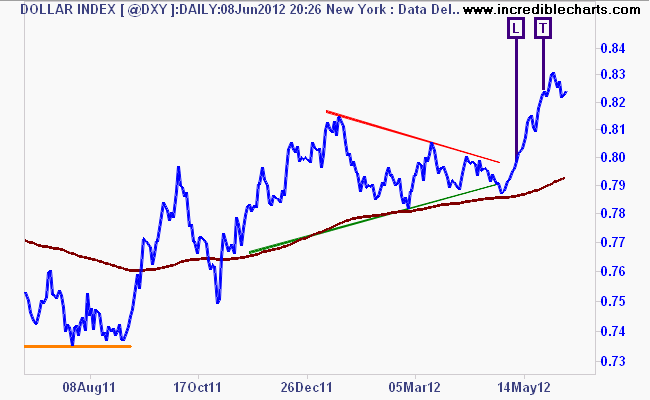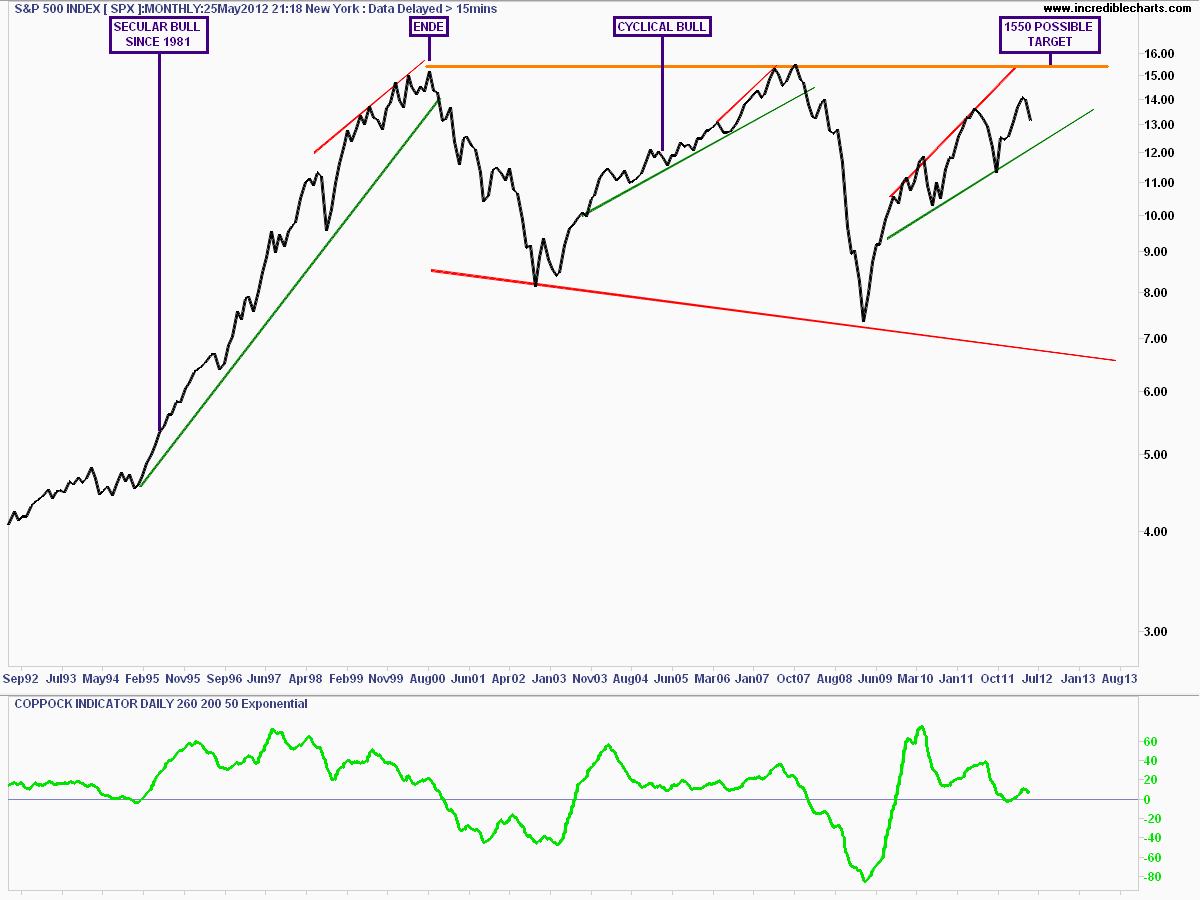
So where have the markets gone this week? Past the daily noise and headlines, this weekly chart heavy post will examine the major markets (debt, commodities, currencies then shares) with the Australian investor in mind.
I’ve since found Twitter to be a very reliable insight into the behaviour of the permabulls and permabears, its no wonder that some hedge funds are now running their wasted battalions of mathematical PhD’s over algorithms that can use that insight and turn it into profit.
MacroBusiness readers will have to settle for my interpretation alone, although I do use non-discretionary algorithms myself for trading decisions. The whole point to this? The spin this morning, indeed all week, has been fascinating, and shows that the allocators of risk around the world are caught and confused, as I suggested would be the case until the FOMC meeting on June 20. I don’t think “open mouth operations” from the Fed are going to be enough to satisfy the hunger of the “free” markets for more support.
Currencies
Let’s start this week’s analysis as always with the clearest barometer of risk, the reserve currency of the world, the US Dollar. For new readers (and this column is growing in views, many thanks) the US Dollar Index (DXY) is the best way to view this, although it doesn’t include the AUD, we’ll come to that shortly.
Last week I reckoned that “in the very short term (DXY) looks like pausing or topping, even though it is the “unrisk” security. This is due to its WAY overbought status on the daily charts (and the moving averages have stacked, another indicator)”
We’ve had a small setback, you can see where my position/hedging system tightened, but I still contend it’s going to 88-89 points level before a third trigger of monetary easing is pulled, although we had the Fed Reserve Chairman Ben Bernanke this week pouring cold water on the idea.
As a barometer for risk – remember, “risk-on” means capital flows away from USD denominated assets, like US Treasuries and cash towards “risk” assets like shares and commodities, and vice-versa – I would suggest that if the current setback turns into a correction and the DXY falls below 81 points, that risk markets will rally hard:
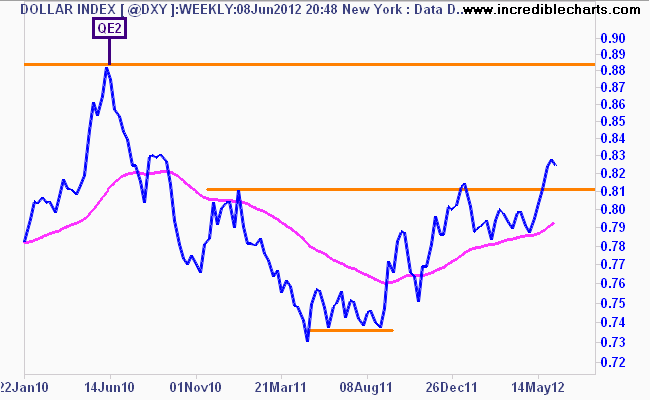
Euro (EUR/USD) – the trouble “golden” currency remains under pressure in the short and medium term, but I always like looking at the monthly chart first, where as I noted last week price is bouncing off support at 1.23 against the USD:
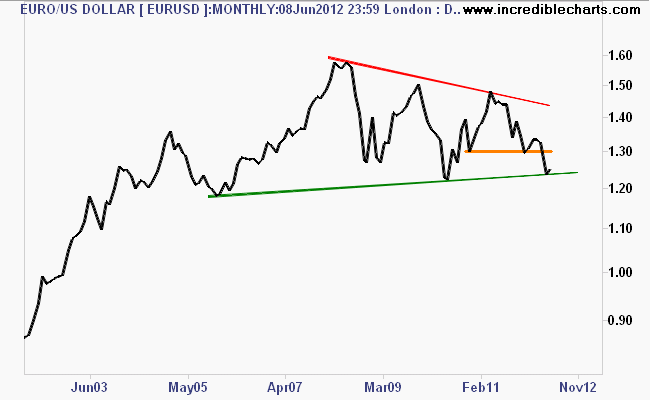
Last week I also said the Euro was “definitely oversold in the short term (my system has tightened its stop)” and indeed we saw a little bounce from 1.235 to almost 1.26, but this strength looks very weak indeed. On the daily chart below you can see price is still well below the 200 day moving average and in a downtrend. It would take a breakout above 1.32 – only likely on a new LTRO or EuroBond Mk 1 or QE3 IMO (sorry for the acryonms) – for a new uptrend to emerge:
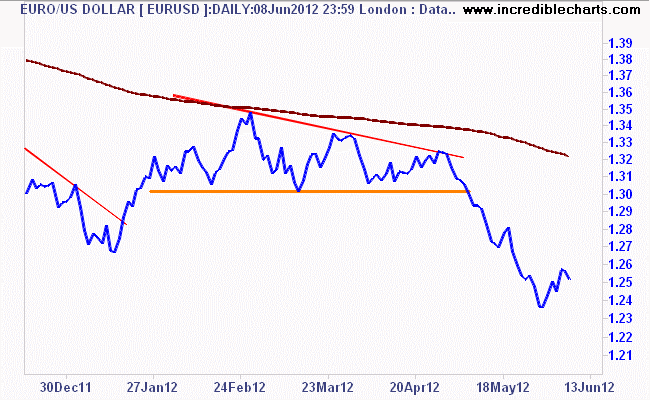
Yen – USD/JPY I watch this and the AUD/JPY pair very closely, along with the Nikkei 225 Japanese sharemarket, which remains in a secular bear market, a history most permabulls purposely (?) ignore. The USD/JPY had a bounce this week, but met resistance at its 200 day moving average (signalling the bears are in charge) just below 80 Yen – I’m watching for a breakout above that key level, but remember this too is a secular bear market:
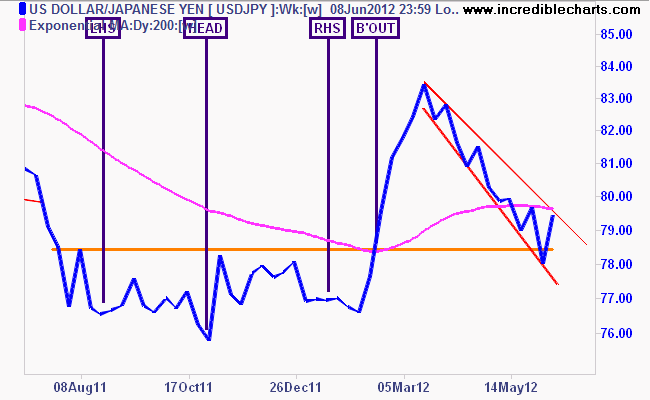
Equities follow currencies (usually), which is why I cover them in this fashion – here is the weekly chart of the Nikkei 225 since the GFC – even though they had an impressive GDP print for the last quarter (beating the “good” Australian print), its not translating into gains on equities (again, don’t tell the permabulls):
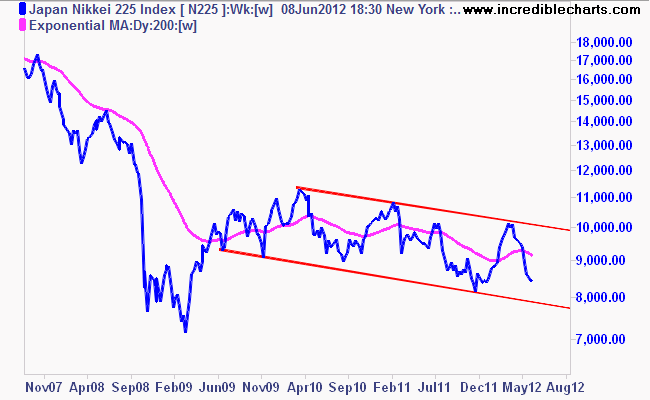
Aussie (AUD/USD) saw a big bounce this week, where a series of “extraordinarily good numbers” were printed (GDP, unemployment, trade balance), which coupled with a rebound from recent sell-off in risk saw the Aussie almost come back to parity. For those short the AUD, this represents a great opportunity to scale in again (my position system closed out its short on Wednesday). Here’s my short term daily chart, where I said last week “in the short term we could see a bounce, as its WAY oversold and decelerating“:
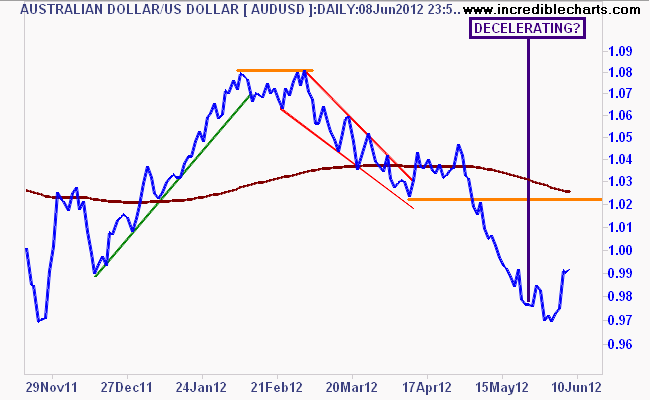
The orange line on the chart above would be the key level I’m looking for, for a return to risk, as the AUD is THE risk proxy for global capital speculation. In the medium term, the Aussie is respecting the 96 cent level as marked on the weekly chart below, where it has been rising in a series of steps as monetary stimulus floods world markets since the GFC. I would contend it requires another round of stimulus for the Aussie to maintain this current range (96 to 110), because the macro forces against the Aussie are too great:
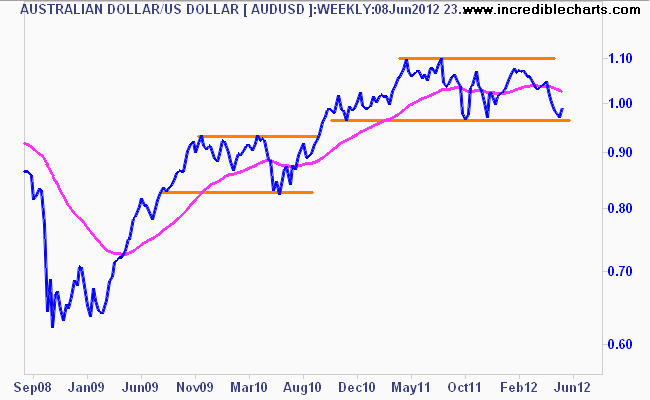
Gold (USD) is it a currency? maybe – but it looks weak against the un-gold currency, the USD. This week as I watched the twitter feed react to Ben Bernanke’s speech, I watched the gold price slip, then fall, the tumble 2% – whereas only two days prior, it had risen 4%! Let’s place these short term moves in context with the daily chart first, which clearly shows the weakness (inability to breach 200 DMA or series of lower highs from late February):
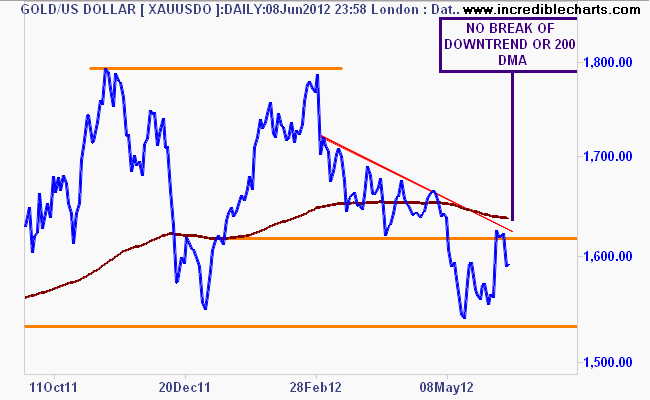
In the medium to long term, gold remains in a secuular bull market, but has had an almighty pause after nearly reaching $2000USD an ounce back in August last year. Price is still respecting support whenever it nears $1550USD an ounce, on speculation that falls in other risk markets (remember, gold is effectively a speculative risk commodity, underpinned by the real trend of monetary profligacy) would be supported by another round of stimulus to keep traders up to date on the latest Lambo’s and Maseratis (I’m still driving a Honda, for the record)
This weekly chart is very illustrative – the weekly gold price has been below the 200DMA for its longest period yet, and the uptrend since the GFC low has been broken. The contrarian in me thinks that on any gold strength, I’d be buying out-of-the-money put options on a breakdown of the gold price, because if it breaks support (probably alongside a selloff in other risk markets) then a fall to $1300 USD is very likely.
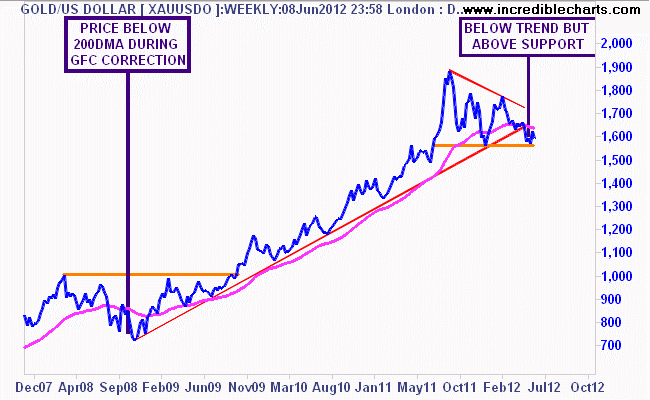
Debt Markets
US 10 year T-Notes (TNX) – last week I said that technically, T-note price action (in this case yields) continue to be a pretty self explanatory trade as it hits new historic lows . Here’s the monthly chart to view the secular trend – although we had a very small bounce this week:
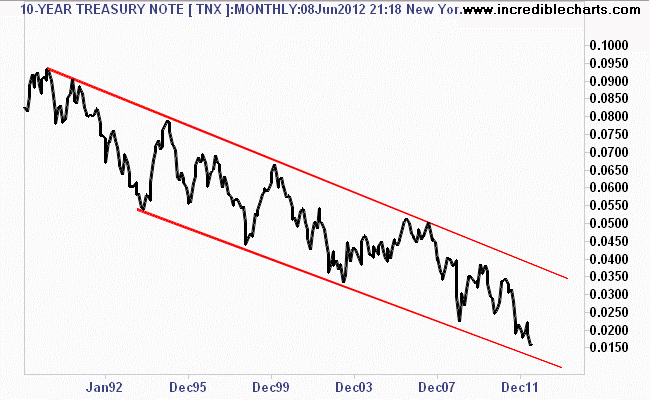
Australian 10 year bonds: if a mainstream economist had been told a year ago that bond yields – then at 5.1% would be under 3% within 12 months they would have laughed in your face (don’t ask them about private debt, it makes them very confused). Buts that’s where we are today – well actually no, they are over 3%, after being extremely overbought in the last couple of weeks, the inevitable selloff occurred this week. I did note this in our weekly MB/MA briefing, although we still contend yields are likely to go lower.

Megabank Credit Default Swaps (CDS): the 5 year swaps have fallen this week, after almost reaching 200 points on a huge run up from March, due to the continued ructions (and end of LTRO) in European banks. Dog I wish there was a retail level product to trade these swaps! (some puts and calls would be lovely, thank you very much Mr (or is that Dr?) Financial Engineers)

Commodities
CRB Index. The other great barometer for Aussie stocks, the CRB Commodities index looker weaker still, as the prospects of slower global growth weigh down speculation on commodities. The weekly chart is not just turning bearish, it is bearish, with a 27% correction since the April 2011 high.
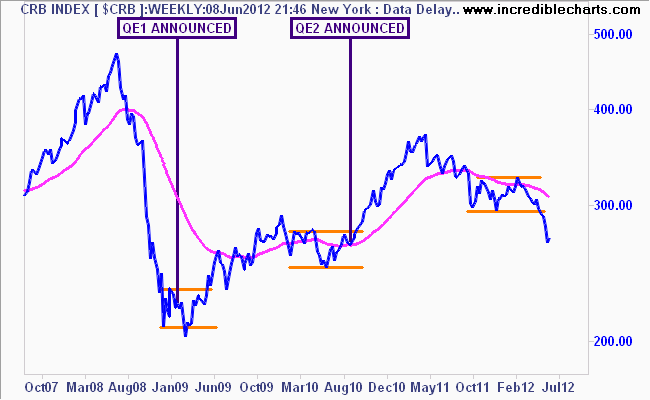
Last week I said the CRB was “tremendously oversold is the short term picture, having fallen from over 10% since my recent short call, I would not be surprised to see a bounce in the short term, particularly on QE rumors.” My short term trading system was short again after the last dead cat bounce, and may turn out to put another short on after this week’s tepid bounce, but I am wary of doing so coming into the FOMC meeting (where QE3 is expected):
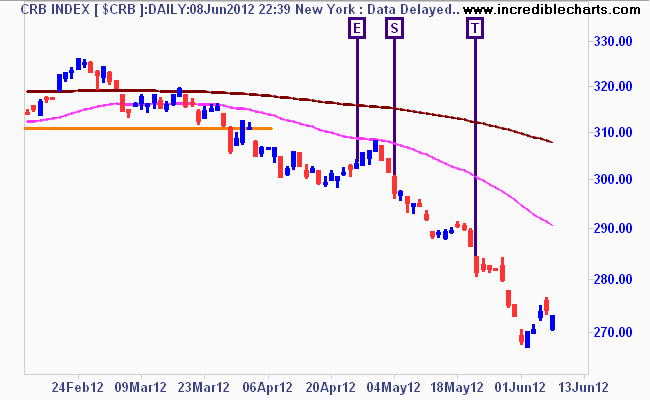
ICE Brent Crude – I did suggest that the falls in crude were too fast, and that it should settle around $102USD per barrel but I got that wrong! Crude has continued to fallen, and maybe the first warning sign that not all is well with global growth. There was a very short term bounce as Brent fell below $100USD per barrel:
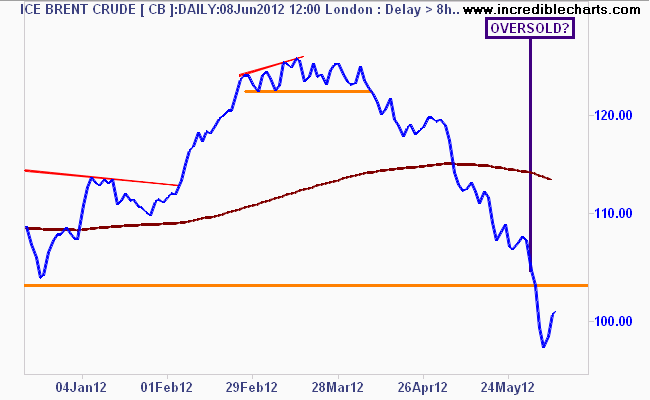
The weekly chart below suggests that Brent is about to break its trendline from the post GFC low (reflecting the secular trend within oil prices). Its quite obvious that the QE2 surge was unsustainable, but are we overcooking it to the downside now? I’m waiting for stimulus signals before I start to load up on OOO ETF’s again…as I think many others who are watching the same charts are!
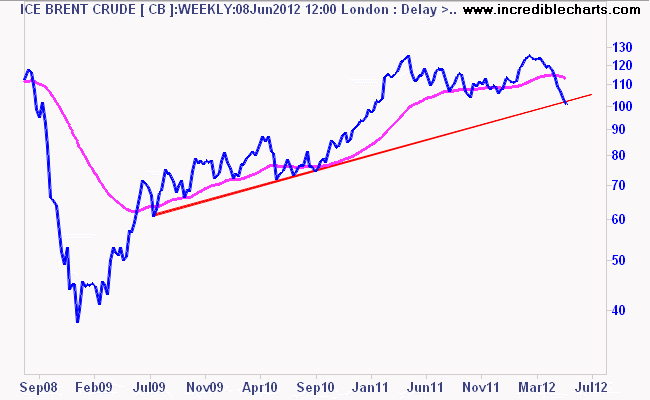
Stocks
S&P500 – the broader US market has been in a cyclical bull market since March 2009 – check my podcast here for the full monthly/secular explanation or my post here on labelling markets. Here is the monthly chart explaining those moves since the end of the secular bull market in 2000 – its full size, so click on to expand and see my notes:
Now that the US economy is seeing signs of slowing down, with the non-farm payroll numbers surprising to the downside (and crushing hopes of another “buy the dip” rally) is this cyclical bull market over? The technical picture says the bull remains, unless we breach the trendline from the post-GFC low, touched during Greece Crisis Mk 1 and 2 at just over 1200 points:
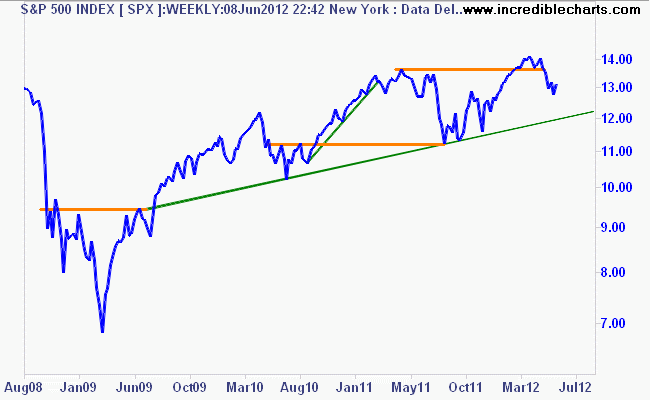
That key level is also the highest low experienced during the volatile ranging period before the LTRO induced rally before Xmas. Here is my updated daily chart where I’ve marked my position system entry and exit points on both the long and short side for the last six months -its been a busy time:
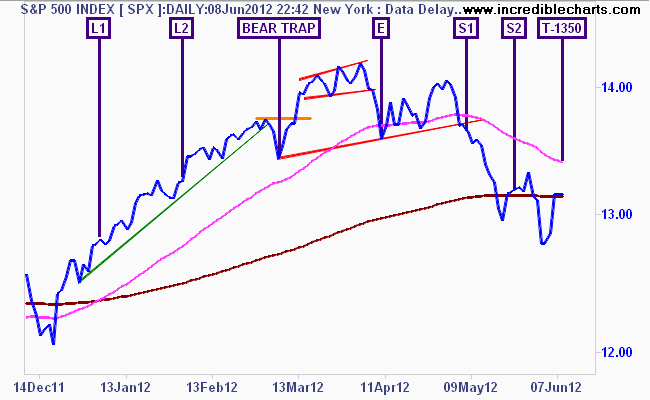
The current move below the 200DMA could be the start of another trap – but what kind? Bull or bear? Either way, I’ve tightened my system as the bulls seem to be gaining the upper hand. One should be careful remaining short in a market on the edge of getting liquidity from a central bank determined to rebuild balance sheets.
S&P/ASX200 (XJO) – finally to our local market, which continues to suffer under the weight of all this “doom and gloom” stress. Just as I write this, the official May inflation figures for China have come out and explain why the PBOC cut interest rates earlier in the week. This excited the permabulls – particularly those adamant that our resource stocks look cheap, and it looked like we had found a bottom, but again it pays to remember (literally) that our market is out of the hands of local forces and continues to track the US, so we ended the week and the year where we started!
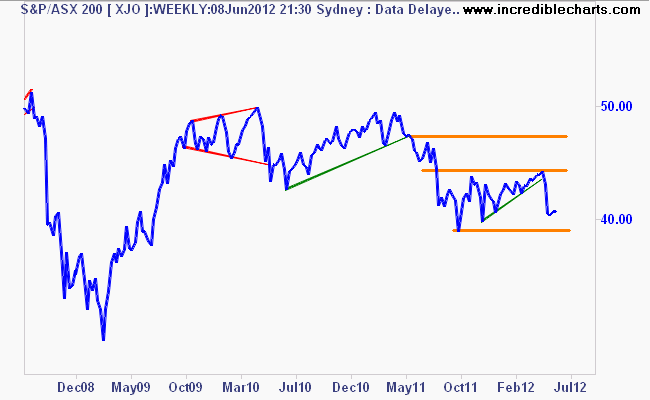
Note the key levels:
- resistance at 4400 points – the previous high of the rally and the level the market must breach to turn a short term rally into a sustained bear market rally
- the next resistance at 4700 points, the level at which, if the market rallies, most of those who bought in the last 12 months will sell and get out IMO
- support at 3900-4000 points – the previous low of the correction – which must be maintained if we are to see any new cyclical bull market
You can see that last level more clearly on the monthly chart, which is still dancing the jig of a secular bear market, moving in accordance with historical percentage and time. If that key level is breached the trajectory is likely to be the trendline from the previous monthly lows, and indeed, the will of so many superannuants (who have yet to see a positive return over the last 4 years) and baby boomers will be broken. When the major mainstream publications start reflecting this view (probably six to 12 months after the last baby boomer sells out?) it will likely be the start of a new secular bull market in stocks….
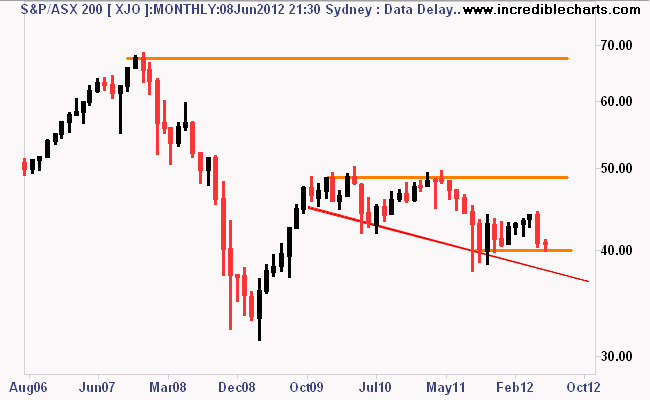
Disclaimer: The content on this blog should not be taken as investment advice. All site content, including advertisements, shall not be construed as a recommendation, no matter how much it seems to make sense, to buy or sell any security or financial instrument, or to participate in any particular trading or investment strategy. The authors have no position in any company or advertiser reference unless explicitly specified. Any action that you take as a result of information, analysis, or advertisement on this site is ultimately your responsibility. Consult someone who claims to have a qualification before making any investment decisions.
